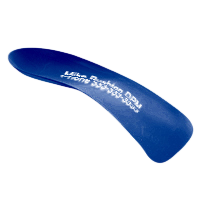Sunday, November 4, 2012
Custom Orthotics in Ski Boots, Improved Control and Comfort
Custom orthotics are an underutilized component for skiers. They can improve control and comfort.
The typical down hill skier's lower extremities never goes through a complete gait cycle. They ideally should have limited lower extremity biomechanics between midstance and the beginning of propulsion. Knee flexion is during the entire contact phase. When initiating a turn a skier will maintain their control by directing the downhill knee medially and transferring the load in to the foot over the inside edge. This is done by internally rotating their tibia, causing a closed kinetic chain pronation of the foot which transfers the pressure through the boot onto the ski edge. The higher level skier has a more subtle dynamic and reverse is true for the beginner. When a skier has an over pronated or unstable foot, they may have more difficult time turning as the medial arch of the foot may collapse within the ski boot before the edging force can be transferred to the ski edge.
In the normal foot gait cycle, subtalar supination and pronation are primarily influence by foot structure, shoe construction and the supporting surface. In ski boots, subtalar joint supination and pronation are responding to knee function. In a normal ski boot, there may be too much medial room and there will be an inefficient transfer of force to the ski edge as the tibia and knee move medially. That is were a ski orthotic comes in.
An orthotic from Atlas Biomechanics is usually molded indirectly to the foot in neutral position. This can be done either placing the heated orthotic blank under the insole inside ski boot or on the ground. By controlling the medial arch and preventing over pronation (or collapsing) the skier will have a more efficient transfer of energy and will decrease overall foot and knee fatigue. A properly fitted ski orthotic will make sure there is no wasted space under the foot, therefore allowing the ski to turn quicker and with more power.
Ski boots are known for being less than comfortable due to unsupported insoles. A great way to improve comfort and support is to create a custom orthotic from Atlas Biomechanics under the boots insole. Our athletic heat mold orthotic blanks are only 1.4 mm thick and are excellent for low volume ski boots. They can be private labeled with your name and phone number on the orthotic device.
Teri Green, Atlas Biomechanics
www.atlasbiomechanicswww.atlasbiomechanics.com
Subscribe to:
Post Comments (Atom)


No comments:
Post a Comment